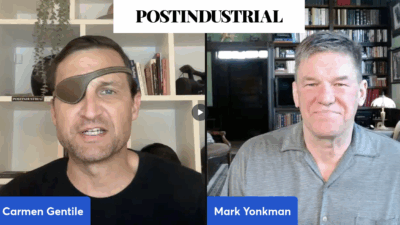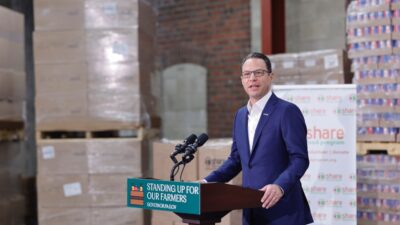Mark Yonkman is the founder of the newly created Super PAC Reclaim the Rural Vote and a rural vote messaging expert. Mark’s background straddles not only the rural and urban worlds but the black/white, gay/straight, and farm/professional worlds as well. Read more of his Rural Whisperer columns here.

Rural voters have long been sensitive to the threat that China presents to the U.S. Rural voters also understand that tariffs are a tactical tool and not a strategy. I hear a consistent narrative that my neighbors are happy to pay higher prices so long as the result is lessening dependence on China and returning the manufacturing of strategic goods to North America.
It is never about jobs. Not many in the rural Upper Midwest (other than rural areas around major metropolitan areas) want a factory job. This part of the country was populated through homesteading small farms and was at one point comprised of small business owners – farmers and shopkeepers – until the Industrial Revolution. That ethos still persists. You might get a different answer if you asked someone in the rural South. In the rural Upper Midwest, where the swing states are located, it is more about national security, retaining manufacturing and technological expertise, and ensuring that our supply chain risks are minimized.
The Chinese are seeking to dominate the U.S. technologically and militarily
When my father took me to the Walmart that had just opened in the city nearest our farm, we walked around, and he turned to me and said, “90% of the things in here no one really needs – and they will end up throwing them out in the next couple of years. And they are all made in China, which will take that money and invest it in technology and in their military.” He was right. He was also one of the last of the Greatest Generation, who had farmed with a team of horses and viewed everything through a military and national security lens.
Rush Doshi, former deputy senior director for China, wrote this week that China is pulling ahead in multiple technology sectors, is already at 70% of the GDP of the U.S., and already exceeds America’s industrial capacity. And that we have grown dependent on China.
While Trump recognized this threat, his response allowed China to continue its march towards technological and manufacturing dominance so long as China continued to buy our commodity exports, including corn and soybeans. As Mr. Doshi points out, these exports do nothing to increase American manufacturing strength.
Rural voters in the northern swing states seem to be very well-versed in exactly this issue.
Democrats make a clumsy response to Trump’s clumsy idea to address the threat China presents
Trump’s magic is that he somehow figures out what is bothering the rural voter in the Upper Midwest and then talks to them about it. To address the Chinese threat, he has proposed a 60% tariff on Chinese goods. Voters here respond universally that, indeed, we need to address this threat, that at least Trump is trying to do something about it, and that they are willing to pay higher prices if it actually re-vitalizes American manufacturing and preserves technological know-how.
Do tariffs work? Sometimes. After Trump imposed tariffs on foreign steel, one new foundry opened in the U.S. The tariffs worked. And Biden kept the tariffs in place for good reason. Will the 100% tariffs on electric vehicles work? Probably. What Harris should focus on is making sure U.S. auto manufacturers use that relief to up their game and catch up to the Chinese rather than using the breathing room to increase profits in the short term.
The Harris campaign’s response has been to argue that these tariffs will cost each American $4000. By saying these tariffs will cost each American $4000, the Harris campaign response has simply put a spotlight on how bad the issue has become over the past 4 years. A $4000 tax implies I am spending $7000 per year on Chinese imports, or $14,000 for my daughter and me combined. If so, this is indeed a problem that is even worse than I thought. It also implies that I won’t be able to change my behavior and buy American goods because that manufacturing simply does not exist in the U.S. I have to buy from China.
A neighboring farmer who also works for an electrical contractor suggested to me last week to look at all of my spending for the prior month and where each item was made – he is aware I am restoring the one-room schoolhouse my ancestors built and in the middle of a lot of electrical work. He pointed out that anything with any level of complexity that he buys is from China.
What did I buy? I bought two tires for my tractor, several rolls of insulation, a cement mixer, 20 lbs of screws, several lithium batteries for power tools, and numerous electrical items like step-down transformers, specialty LEDs, a solar power inverter, and a charge controller, and numerous electrical supplies. The only two items made in the U.S. were the tires and the insulation. Both low technology products. Everything else was from China. It was sobering to note that anything that required technological expertise was made in China. It would have been one thing if my purchases came from a dozen different countries. But they didn’t – they all came from China.
A rural farmer pointed this issue out to me. Yet I have read Harris’ economic plan and it does not address any immediate steps to stop the bleeding and blunt this threat from China. Her plan states that she will leave current rules in place and encourage American companies to do better, with tax breaks and incentives, education, and with a focus on investing in poor and minority communities. These are laudable long-term goals but do not address the immediate crisis. It reads like one prong of what should be a two-prong approach. The 100% tariff on EVs is the second prong – tariffs can immediately slow the bleeding.
Conclusion
The Harris ads have backfired where I live. The $4000 claim has merely served to highlight how dependent we are on China. And it highlighted how many products that require technological and manufacturing expertise have moved to China. For the Harris campaign to point this out rather than touting their own solution was tone-deaf to one of the large concerns rural voters have in the Upper Midwest.
Democrats would be well served to change this messaging to something more constructive in the Upper Midwest. It is somewhat baffling because I believe that the Biden administration has done some things to address this issue. Why not lean into those?
I noted this weekend that after the vice presidential debate, the View and 60 Minutes interviews, Walz’s attack on the Electoral College, and the $4000 “tax” ads in the last two weeks, numerous Trump signs popped up in my rural area. It is always the little things that matter.







